Page 270 of 466
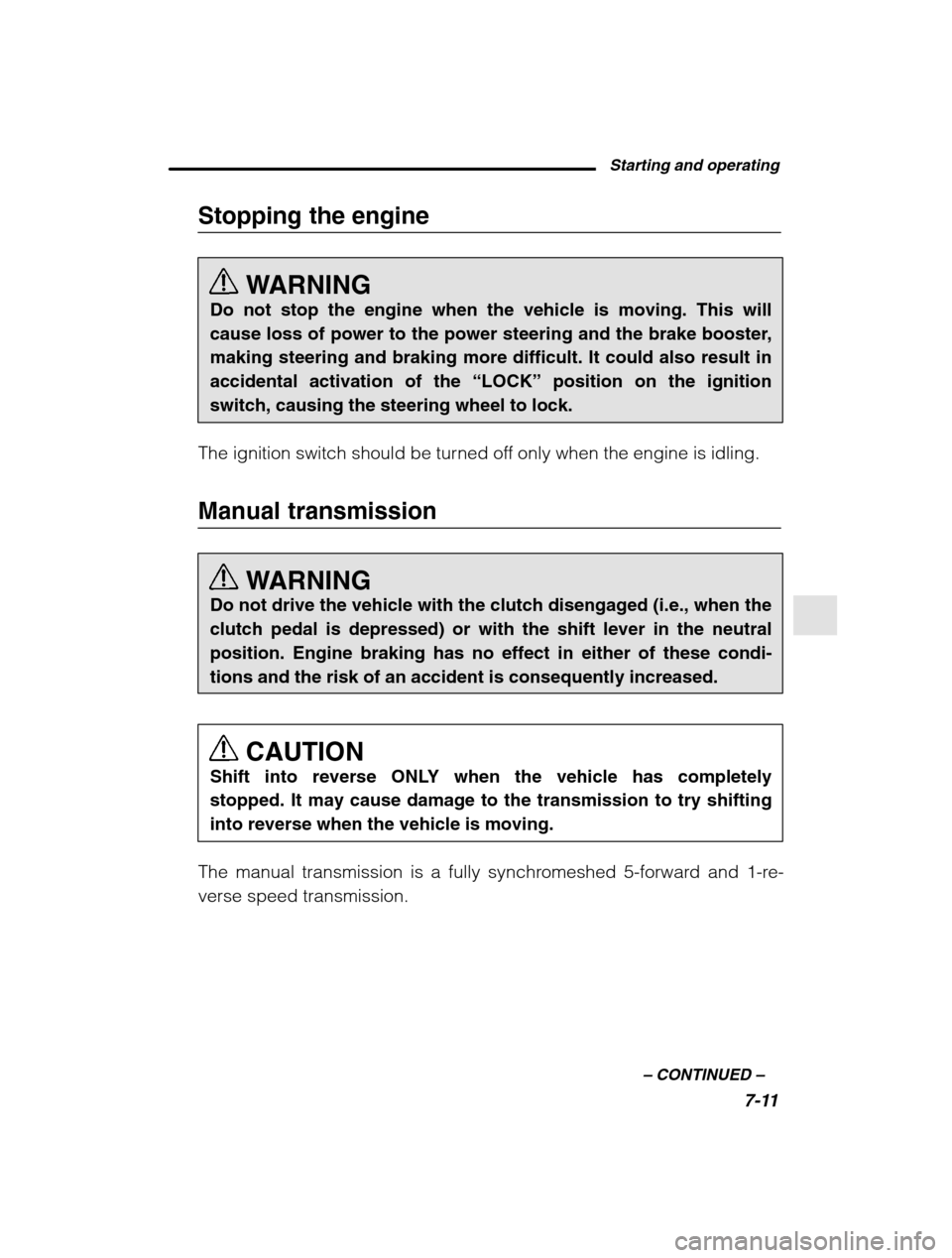
Starting and operating7-11
–
CONTINUED –
Stopping the engine
WARNING
Do not stop the engine when the vehicle is moving. This will
cause loss of power to the power steering and the brake booster,making steering and braking more difficult. It could also result in
accidental activation of the “LOCK” position on the ignition
switch, causing the steering wheel to lock.
The ignition switch should be turned off only when the engine is idling.
Manual transmission
WARNING
Do not drive the vehicle with the clutch disengaged (i.e., when the clutch pedal is depressed) or with the shift lever in the neutralposition. Engine braking has no effect in either of these condi-tions and the risk of an accident is consequently increased.
CAUTION
Shift into reverse ONLY when the vehicle has completelystopped. It may cause damage to the transmission to try shiftinginto reverse when the vehicle is moving.
The manual transmission is a fully synchromeshed 5-forward and 1-re-
verse speed transmission.
Page 273 of 466
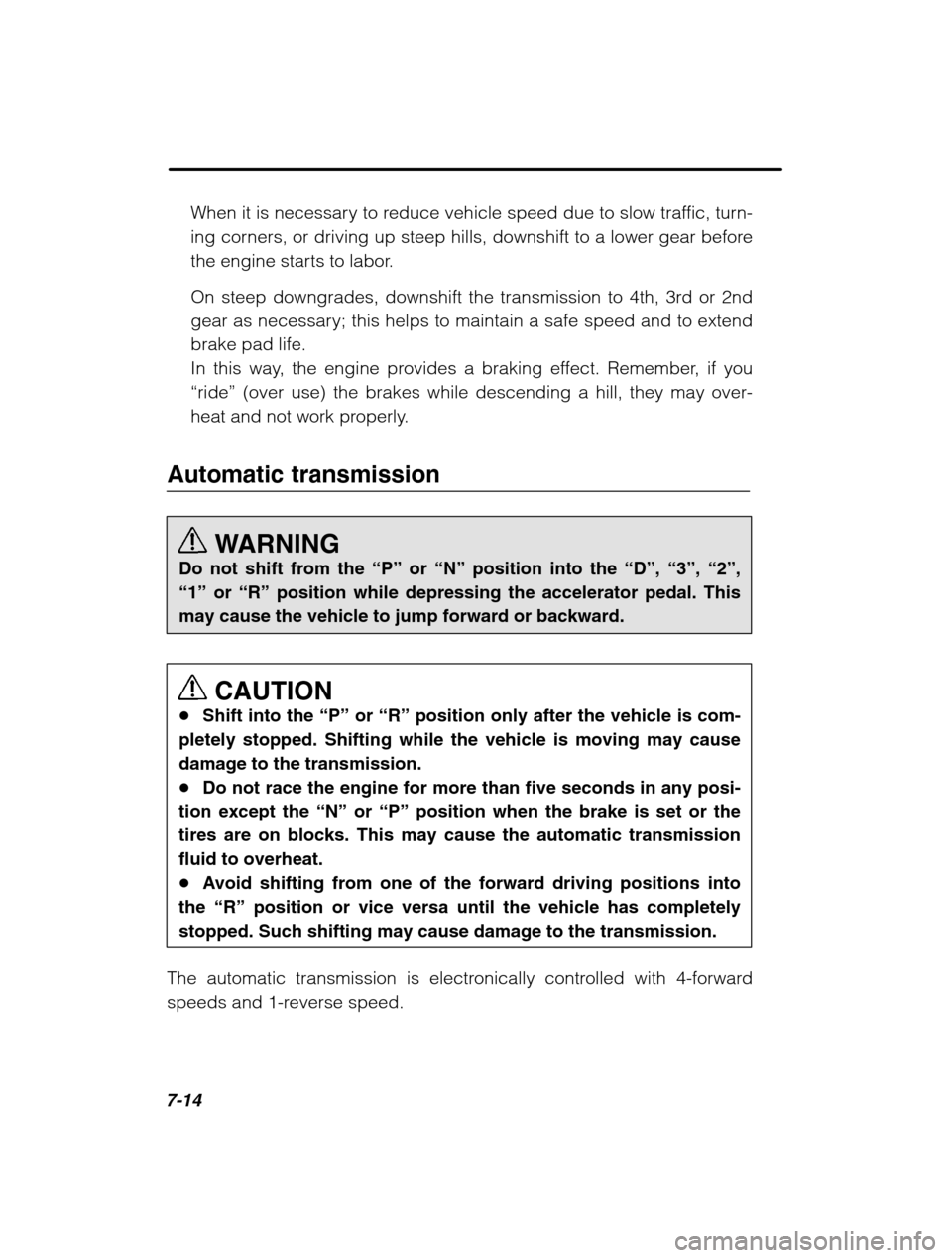
7-14
When it is necessary to reduce vehicle speed due to slow traffic, turn-
ing corners, or driving up steep hills, downshift to a lower gear before
the engine starts to labor.
On steep downgrades, downshift the transmission to 4th, 3rd or 2nd
gear as necessary; this helps to maintain a safe speed and to extendbrake pad life.
In this way, the engine provides a braking effect. Remember, if you
“ride” (over use) the brakes while descending a hill, they may over-
heat and not work properly.
Automatic transmission
WARNING
Do not shift from the “P” or “N” position into the “D”, “3”, “2”,
“1” or “R” position while depressing the accelerator pedal. This
may cause the vehicle to jump forward or backward.
CAUTION
� Shift into the “P” or “R” position only after the vehicle is com-
pletely stopped. Shifting while the vehicle is moving may cause
damage to the transmission.� Do not race the engine for more than five seconds in any posi-
tion except the “N” or “P” position when the brake is set or the
tires are on blocks. This may cause the automatic transmissionfluid to overheat.� Avoid shifting from one of the forward driving positions into
the “R” position or vice versa until the vehicle has completely
stopped. Such shifting may cause damage to the transmission.
The automatic transmission is electronically controlled with 4-forward
speeds and 1-reverse speed.
Page 275 of 466
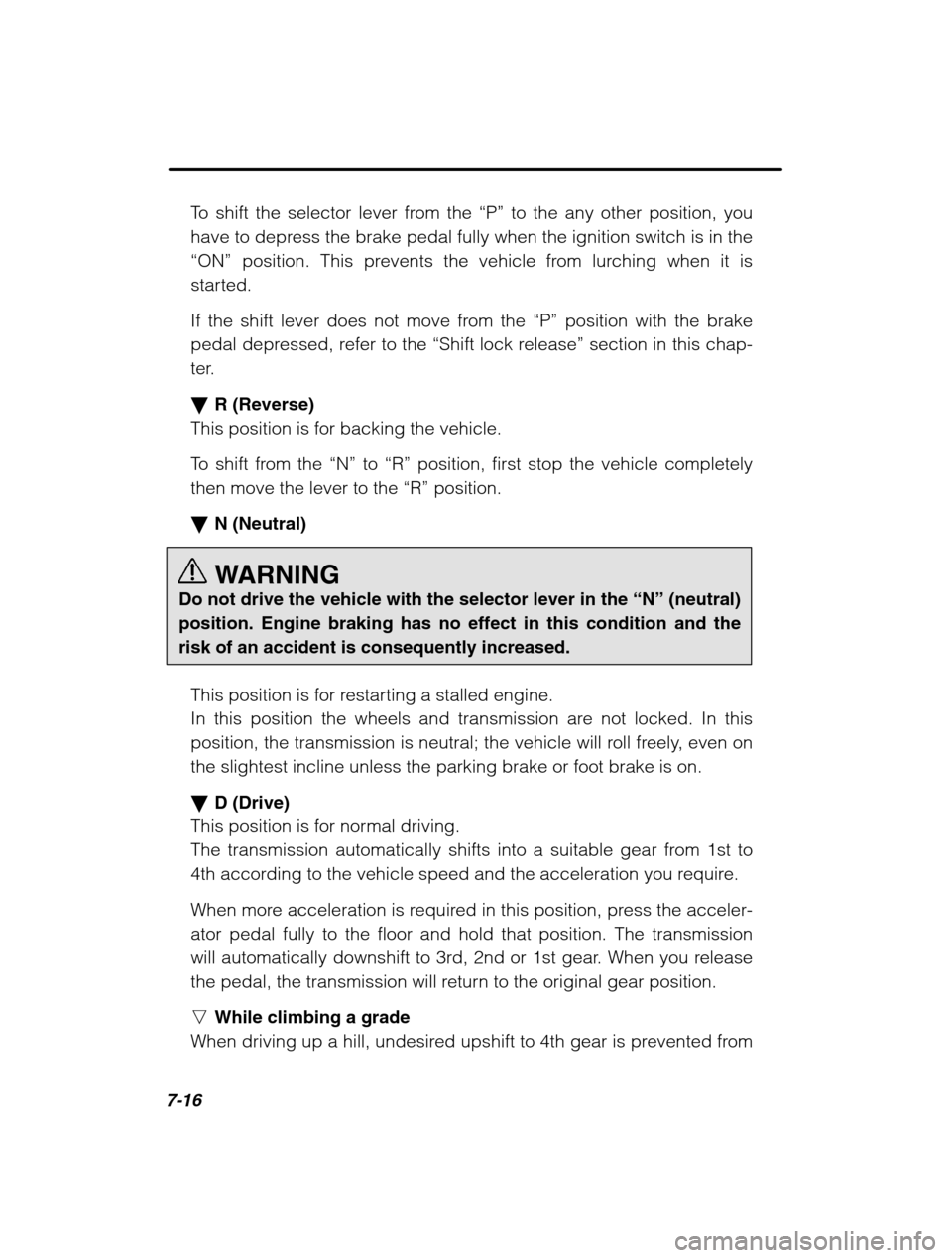
7-16
To shift the selector lever from the “P” to the any other position, you
have to depress the brake pedal fully when the ignition switch is in the
“ON” position. This prevents the vehicle from lurching when it is
started.
If the shift lever does not move from the “P” position with the brake
pedal depressed, refer to the “Shift lock release ” section in this chap-
ter. � R (Reverse)
This position is for backing the vehicle.
To shift from the “N” to “R” position, first stop the vehicle completely
then move the lever to the “R” position.
� N (Neutral)
WARNING
Do not drive the vehicle with the selector lever in the “N” (neutral)
position. Engine braking has no effect in this condition and the risk of an accident is consequently increased.
This position is for restarting a stalled engine.
In this position the wheels and transmission are not locked. In this
position, the transmission is neutral; the vehicle will roll freely, even onthe slightest incline unless the parking brake or foot brake is on. � D (Drive)
This position is for normal driving.
The transmission automatically shifts into a suitable gear from 1st to
4th according to the vehicle speed and the acceleration you require.
When more acceleration is required in this position, press the acceler- ator pedal fully to the floor and hold that position. The transmission
will automatically downshift to 3rd, 2nd or 1st gear. When you release
the pedal, the transmission will return to the original gear position. n While climbing a grade
When driving up a hill, undesired upshift to 4th gear is prevented from
Page 278 of 466
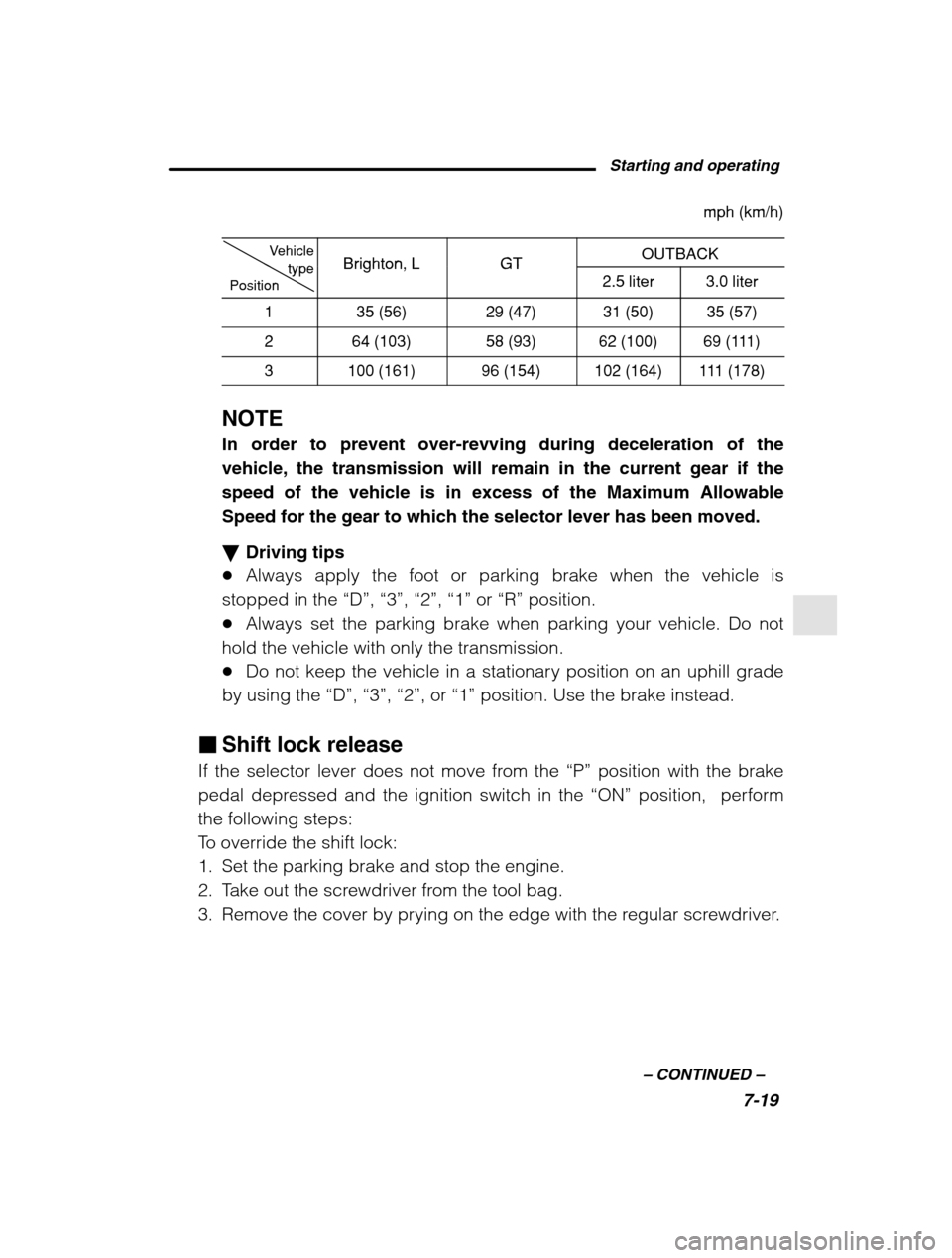
Starting and operating7-19
–
CONTINUED –
mph (km/h)
Vehicle
typeBrighton LGTOUTBACK
PositiontypeBrighton, LGT2.5 liter3.0 liter
135 (56)29 (47)31 (50)35 (57)
264 (103)58 (93)62 (100)69 (111)
3100 (161)96 (154)102 (164)111 (178)
NOTE In order to prevent over-revving during deceleration of the
vehicle, the transmission will remain in the current gear if thespeed of the vehicle is in excess of the Maximum AllowableSpeed for the gear to which the selector lever has been moved. � Driving tips
� Always apply the foot or parking brake when the vehicle is
stopped in the “D”, “3”, “2”, “1” or “R” position.
� Always set the parking brake when parking your vehicle. Do not
hold the vehicle with only the transmission. � Do not keep the vehicle in a stationary position on an uphill grade
by using the “D”, “3”, “2”, or “1” position. Use the brake instead.
� Shift lock release
If the selector lever does not move from the “P” position with the brake
pedal depressed and the ignition switch in the “ON” position, perform
the following steps:
To override the shift lock:
1. Set the parking brake and stop the engine.
2. Take out the screwdriver from the tool bag.
3. Remove the cover by prying on the edge with the regular screwdriver.
Page 280 of 466

Starting and operating7-21
–
CONTINUED –
Power steering
CAUTION
Do not hold the steering wheel at the fully locked position left or right for more than five seconds. This may damage the powersteering pump.
The power steering system operates only when the engine is running.
If you lose power steering assist because the engine stops or the system
fails to function, you can steer but it will take much more effort. NOTE Right after the engine has been started and before it has warmed up, you may hear a noise coming from areas adjacent to the powersteering pump which is located at the right-front area of the enginecompartment. This noise is normal. It does not indicate power steer-ing system trouble. Braking � Braking tips
WARNING
Never rest your foot on the brake pedal while driving. This can
cause dangerous overheating of the brakes and needless wearon the brake pads and linings.
� When the brakes get wet
When driving in rain or after washing the vehicle, the brakes may get
wet. As a result, brake stopping distance will be longer. To dry the
brakes, drive the vehicle at a safe speed while lightly depressing thebrake pedal to heat up the brakes.
Page 281 of 466

7-22
�Use of engine braking
Remember to make use of engine braking in addition to foot braking.
When descending a grade, if only the foot brake is used, the brakes
may start working improperly because of brake fluid overheating,
caused by overheated brake pads. To help prevent this, shift into a
lower gear to get stronger engine braking. � Braking when a tire is punctured
Do not depress the brake pedal suddenly when a tire is punctured.
This could cause a loss of control of the vehicle. Keep driving straight
ahead while gradually reducing speed. Then slowly pull off the roadto a safe place.
� Brake system �Two separate circuits
Your vehicle has two separate circuit brake systems. Each circuit
works diagonally across the vehicle. If one circuit of the brake system
should fail, the other half of the system still works. If one circuit fails,
the brake pedal will go down much closer to the floor than usual and
you will need to press it down much harder. And a much longer dis-
tance will be needed to stop the vehicle. � Brake booster
The brake booster uses engine manifold vacuum to assist braking
force. Do not turn off the engine while driving because that will turn off
the brake booster, resulting in poor braking power.The brakes will continue to work even when the brake booster com-
pletely stops functioning. If this happens, however, you will have to
push the pedal much harder than normal and the braking distance
will increase.
Page 282 of 466
Starting and operating7-23
–
CONTINUED –
�Disc brake pad wear warning indicators
OM-H0163
The disc brake pad wear warning indicators on the disc brakes give a
warning noise when the brake pads are worn.
If a squeaking or scraping noise is heard from the disc brakes whilebraking, immediately have your vehicle checked by your SUBARU deal-
er. ABS (Anti-lock Brake System)
WARNING
Always use the utmost care in driving – overconfidence because
you are driving with an ABS equipped vehicle could easily lead to a serious accident.
CAUTION
� The ABS system does not always decrease stopping distance.
You should always maintain a safe following distance from othervehicles.� When driving on badly surfaced roads, gravel roads, icy road,
or over deep newly fallen snow, stopping distances may be long-er for a vehicle with the ABS system than one without. When driv-ing under these conditions, therefore, reduce your speed and
Page 289 of 466
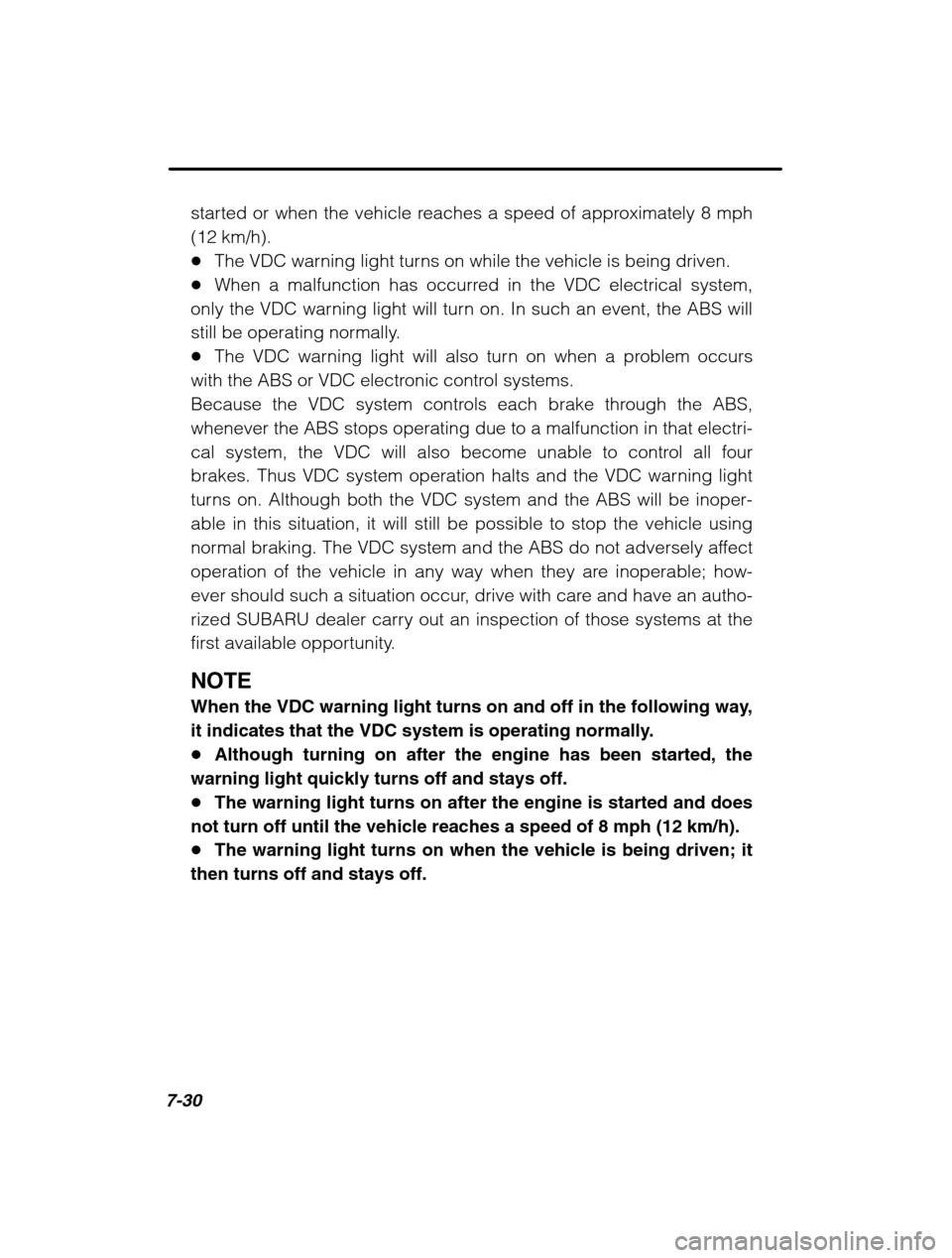
7-30
started or when the vehicle reaches a speed of approximately 8 mph (12 km/h).�The VDC warning light turns on while the vehicle is being driven.
� When a malfunction has occurred in the VDC electrical system,
only the VDC warning light will turn on. In such an event, the ABS will
still be operating normally.� The VDC warning light will also turn on when a problem occurs
with the ABS or VDC electronic control systems.
Because the VDC system controls each brake through the ABS,
whenever the ABS stops operating due to a malfunction in that electri-
cal system, the VDC will also become unable to control all four
brakes. Thus VDC system operation halts and the VDC warning light
turns on. Although both the VDC system and the ABS will be inoper-able in this situation, it will still be possible to stop the vehicle using
normal braking. The VDC system and the ABS do not adversely affect
operation of the vehicle in any way when they are inoperable; how-
ever should such a situation occur, drive with care and have an autho-
rized SUBARU dealer carry out an inspection of those systems at the
first available opportunity. NOTE
When the VDC warning light turns on and off in the following way,
it indicates that the VDC system is operating normally.� Although turning on after the engine has been started, the
warning light quickly turns off and stays off.� The warning light turns on after the engine is started and does
not turn off until the vehicle reaches a speed of 8 mph (12 km/h).� The warning light turns on when the vehicle is being driven; it
then turns off and stays off.